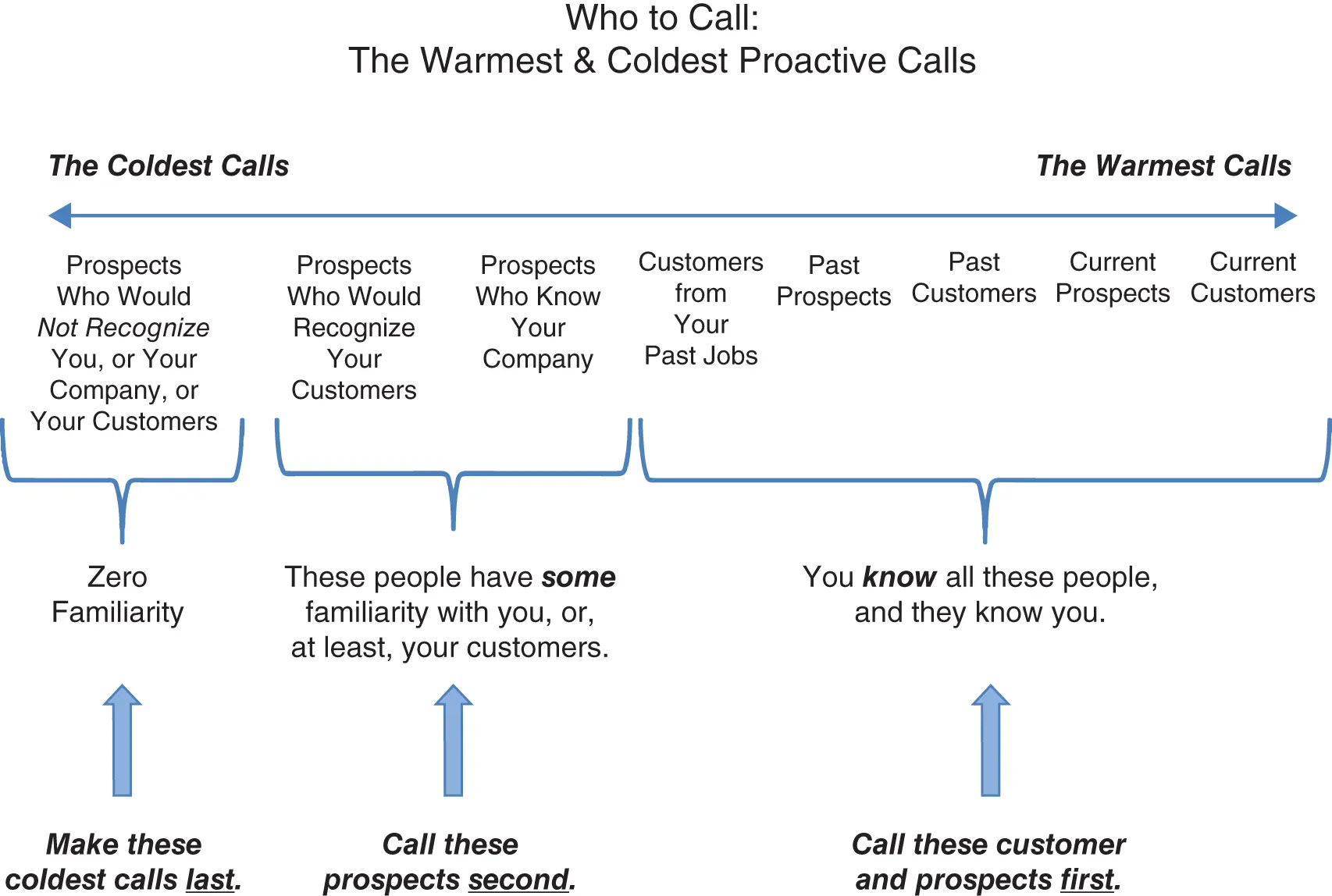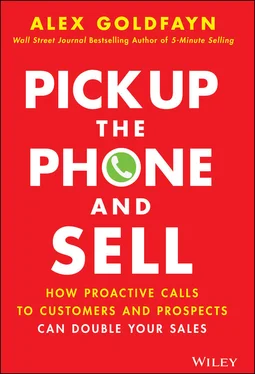Next, lay out your Simple Proactive Call Planner for the week, identifying current and past customers you will call, and current and past prospects. This planner is also in Chapter 7.
Aim to call three to five customers or prospects per day, first thing in the morning.
Who should you call? First, call people who you know– current and former customers, and current and former prospects. Call people who recognize your name or at least your company name. Too many people assume proactive calls only mean cold calls. In fact, you can grow your sales dramatically by only calling people you know and offering to help them ( more) .
We will revisit this in Chapter 23, but for now, these are the people you should be thinking about calling proactively, with the groups in order from right to left – always focusing on the people who know you or at least recognize you or your company.
If you prefer, send a quick text in advance to set a time to speak.
When you call, you will frequently need to leave a voice message(scripts are in Chapter 19), which you should absolutely do.
After leaving the message, send a short text to let the customer know you called, and invite them to get back to you by text or phone, whichever is easier for them. This gives them a choice of how to communicate with you.
With this voicemail-text message communication combination, you will find that about two-thirds of your customers and prospects will get back to you.
On the off chance that the customer picks up the phone, great; you will have a nice, positive conversation. (Simple scripts are throughout Parts 4and 5.)
Log your communication in the Proactive Call Tracker featured in this bookor your own action-tracking or CRM system.

Log the return communications as well, so you remember who you have reached out to and who got back to you.
Update your pipeline daily, because this approach will create countless opportunities for you, as well as a daily progression of customers and prospects toward a quote, a proposal, or a close; and, of course, you'll be securing a lot of new business.
It all starts with a proactive call to a customer or prospect when nothing is wrong.
Make that the tip of your selling spear.
Make it the first action.
And then start making plans for a sudden and significant influx of new business, because the floodgates are about to open.
CHAPTER 3 LEAD WITH THE PHONE: MAKE IT THE TIP OF YOUR SELLING SPEAR
DEFINITION: WHAT IS A PROACTIVE CALL?
The proactive phone call , for our purposes in this book, is defined as calling customers and prospects when nothing is wrong.
Your call can be scheduled with a text message.
While many salespeople only talk on the phone when the customer calls them, this generally focuses the conversation on problems you need to resolve. But this book is about calling the customers proactively, which almost always becomes a conversation about opportunities for you to help the customer.
PROACTIVE CALLS FEED THE SALES MACHINE
Proactive calls feed the machine of your business growth:
They flood your pipeline with new opportunities and advance existing ones.
Specifically, proactive calls expand your pipeline by- Uncovering new leads- Turning leads into prospects
They move prospects toward a proposal or quote.
They move quotes and proposals toward a close.
They close new business.
They expand your business with existing customers.
They build relationships in less time than any other communication pathway we can utilize.
They make you stand out to the point of making you singular, simply because nobody else is calling.
They make it clear that you care about your customers and prospects and that you are thinking about them.
Nothing else is this effective.
PHONE FIRST: LEAD WITH THE PHONE
The key activity in this book is making the proactive phone call (as defined above) the first interaction in your sales process with your customers and prospects.
Not the email inquiry without a call.
But the proactive phone call, when nothing is wrong, for the sole purpose of trying to help the person you are calling.
You can set up the call with a quick text message. That's okay.
You might even send a text or LinkedIn message in combination with a voice message, if you leave one.
But I want you to consider the proactive call the first effort in your selling process.
Before emailing.
Before sending your marketing materials.
Before dropping off your business card with the receptionist during an in-person drop-in with somebody you don't know.
Phone first, rather than waiting until you have a call scheduled much later in your selling process, perhaps to discuss a quote or negotiate.
Lead with the proactive phone call .
Call your customer or prospect and say, “Tom, it's Alex. I was thinking about you. How's your family?”
Catch up.
Connect.
Then pivot to the business:
“What are you working on these days that I can help you with?”
Only good can happen when you ask this question.
Or say, “What projects do you have coming up? I'd like to help.”
This is impressive.
And memorable.
And singular.
Because nobody else is doing this.
Your call will probably be one of the only proactive calls your customer will receive this week, or this month, or even this quarter.
You will stand out, and build relationships and opportunities, very quickly this way.
That's what this book is about.
Phoning first.
PICK UP THE PHONE SUCCESS STORY
“My sales results completely changed when I started making three proactive calls every day. I mostly call customers I haven't talked to in a while. They're always happy to hear from me. And they almost always tell me what they need for that week. Then they call me back themselves to order it again.”
—Marco J.; outside sales, wholesale distributor
THREE TO FIVE CALLS A DAY
Do you know how many calls three calls a day is?
Nearly 800 proactive calls over the course of a year.
Do you know how many calls five calls a day is?
Exactly 1,300 calls per year.
Let's say you have to leave messages on every one of these (which won't happen, of course). But you should expect to usually leave one.
I will arm you with voicemail scripts in Chapter 19that generate return phone calls about two-thirds of the time.
That is, if you leave five voicemails per day – which takes about five minutes – you will get about 867 return calls.
And if you have a less-than-average success rate and only get half the people to return your call, that's 650 conversations with customers and prospects – building relationships and discussing opportunities for you to help them.
How can your sales not grow if you have 650 proactive conversations with people who can pay you?
That's what a system of proactive calling does for you, as opposed to calling only sometimes, when you happen to think of it.
We'll also examine this in the context of the other digital tools available to us and how to use them in combination with the phone – including email, LinkedIn messaging, text messaging, and video conferencing tools like Zoom.
Читать дальше













